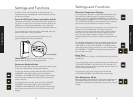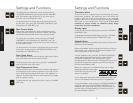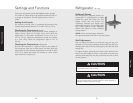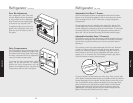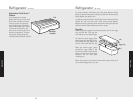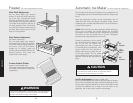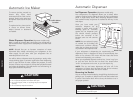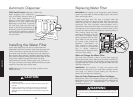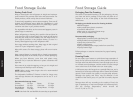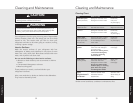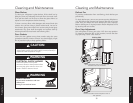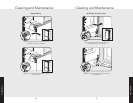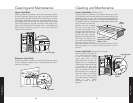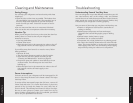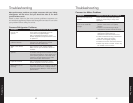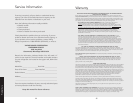
31
30
Operation
Operation
Food Storage Guide
Storing Fresh Food
Wrap or store food in the refrigerator in airtight and moisture-
proof material. This prevents food odor and taste transfer. For
dated products, check use-by date to ensure freshness.
To store leafy vegetables, remove store wrapping. Then tear off
bruised and discolored areas. Wash the vegetables in cold
water and drain, and then place them in a plastic bag or plastic
container and store in your produce drawer.
For vegetables with skins, such as carrots and peppers, store in
plastic bags or containers.
When refrigerating or freezing fruit, wash the fruit and then let
it dry. Store the fruit in plastic bags. Don't wash or hull berries
until they are ready to use. Instead, sort and keep berries in
their original container in the produce drawer, or store in a
loosely closed paper bag on the refrigerator shelf.
Store eggs without washing them. Keep eggs in their original
carton or in your refrigerator's egg bin.
Wipe milk cartons. For best storage, place milk on an interior
shelf.
Keep opened butter in covered dish or closed compartment.
When storing butter in the freezer, wrap it in freezer packaging.
When you have leftovers, cover then with plastic wrap,
aluminum foil, or store the leftovers in plastic containers with
tight lids.
Store meat in its original wrapping, as long as it's airtight and
moisture-proof. Rewrap meat if necessary.
NOTE: When storing meat longer than the recommended
times, freeze the meat.
The Adjustable ColdZone™ Drawer is ideal for longer term
meat storage because the temperature can be set 3˚ to 5˚
colder.
Recommended storage times:
Chicken 1-2 days Bacon 5-7 days
Ground Beef 1-2 days Cold Cuts 3-5 days
Steaks/Roasts 3-5 days Variety Meats 1-2 days
Cured Meats 7-10 days
NOTE: Use fresh fish and shellfish the same day as purchased.
Food Storage Guide
Packaging Food for Freezing
The secret of successful freezing is in the packaging; the way
you close and seal a package of food must not allow air or
moisture in or out, or the quality of the food will deteriorate
while frozen.
Packaging you should not use for freezing includes:
• Bread wrappers
• Non-polyethylene plastic containers
• Containers without lids
• Wax paper or wax-coated freezer wrap
• Thin, semi-permeable wrap
Recommended packaging:
• Rigid plastic containers with tight-fitting lids
• Straight-sided canning/freezing jars
• Heavy-duty aluminum foil
• Plastic-coated paper
• Non-permeable plastic wraps (made from saran film)
• Zip-top freezer bags
Follow package or container instructions for proper freezing
methods.
Freezing Foods
Do not expect your freezer to quick-freeze large quantities of
food; do not load more than two to three pounds of unfrozen
food per cubic foot within 24 hours. Leave enough space for air
to circulate around packages, and be careful to leave enough
room at the front so the freezer door can close tightly.
A full freezer stays cold longer than a partially filled one, and a
freezer full of meat stays cold longer than a freezer full of baked
goods. If food contains ice crystals, it may be safely refrozen,
although the quality and flavor may be affected. If the
condition of the food is poor, or if you feel it is unsafe, dispose
of it.
Storage times will vary according to the quality of food, the
type of packaging or wrap used (airtight and moisture-proof),
and the storage temperature, which should be
0° to 2° F (-18° to -17° C).



